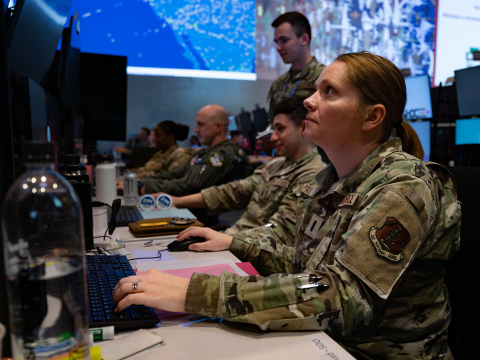Knocking Down Doors for Small Business
Despite some challenges, the U.S. Air Force’s culture is changing in favor of small businesses, according to Valerie Muck, the service’s new director of small business programs.
"The main thing we’re trying to do in the Air Force is create that culture where we’re looking to small businesses first to maximize opportunities. Right now, the culture in the Air Force is in a really good place for that,” said Muck, who has been in the position nearly a year. She made the comments while addressing the AFCEA Small Business Committee at AFCEA’s headquarters building in Fairfax, Virginia.
Muck indicated small businesses offer a number of advantages. “Small businesses are innovative. They’re fast. They’re flexible. They can turn on a dime, whereas when you’re dealing with the services and the Department of Defense, and our large contractors, it’s like turning the Titanic,” she added
For the current fiscal year, the Air Force has awarded 18.5 percent of contracts to small businesses, so far exceeding its 17.5 percent goal. “We actually anticipated going into this year and the following years with a lower percentage because we have a lot of big programs in the Air Force coming down the pipe where we know small businesses will not have the opportunity to be primes,” Muck said.
She cited the Ground-Based Strategic Deterrent System and the KC-46 tanker as two of those large procurements. “We’re really focusing on subcontracting opportunities on those and working with our primes and our program offices to make sure we get small businesses participating … in these big contracts,” she said.
Technology procurements are one of her primary focus areas, and small business can “help support us on the tech side and deliver lethality to the warfighter,” she added.
The Air Force Academy’s CyberWORX program and the AFWERX program, are two programs the Air Force uses to recruit innovators. AFWERX has offices in Las Vegas and Crystal City, Virginia, and is expected to open an office in Montgomery, Alabama. The program will host its next “fusion” event with small businesses and entrepreneurs in June.
Some AFWERX projects will be supported through the Air Force Small Business Innovation Research (SBIR) fund. “We have set aside some funding specifically from our SBIR funds to help fund some of those projects. We’re running that on a dual track with some of our traditional SBIR stuff,” Muck reported. “We want to try it out through AFWERX and see if we can get stuff done a little faster, maybe other transactions … and not have the time and the bureaucracy of doing a traditional contract.”
Some people see SBIR as a “valley of death” where “you go in and you never get anything out,” she said. “Or they see it as a jobs program or a social welfare program. I really want to change that attitude. I want it to be about delivering new cutting-edge technologies for our warfighters and applying those toward real problems that our folks in the field have.”
The cost of sustainment for major programs is one of those problems that needs innovative solutions. “Look at the F-35 program. If we can’t get the sustainment costs down, we can’t buy new aircraft. It’s the same thing with all of our systems,” she said. “The sustainment costs are about 70 percent of the entire lifecycle costs of our systems. We really need to focus on how we can bring those down.”
Unlike her predecessors, Muck is involved in the development of SBIR topics, which determine what kinds of projects receive funding. “I’m interjecting myself—much to the chagrin of others, probably,” she said, adding that she is trying to partner with research organizations, including the Air Force Research Laboratory. “I want it to be a partnership, where we’re moving forward and delivering good stuff for our warfighters.”
Muck indicated one of her primary goals in the coming months is to improve the long-range acquisition forecasts for small businesses. The Office of the Secretary of Defense (OSD) publishes acquisition forecast data, but the Air Force has been somewhat lax about contributing.
That should change soon when the OSD’s System for Acquisition Forecast Input, Retrieval and Engagement (SAFIRE) system comes online. Any awards valued at more than $5 million are required to be included, but officials also encourage inclusion of smaller contracts. The system now has a “public facing capability” and is finally “going live” at the end of June, Muck reported.
When SAFIRE goes online, Air Force data will be included. “We’re going to be submitting a data call out to the program offices in the next couple of weeks with a 30 June suspense. The Air Force information should be fed through [SAFIRE] and should be available after 30 June of 2018. Hopefully, that will make it easier for folks to see what types of things will be coming down the acquisition pipe,” she said.
Although the Air Force culture is growing more friendly to small businesses, it sometimes still requires “busting down doors and changing the culture,” which she describes as “very risk-averse” with “a lot of rules.”
“I’m trying to get some support to do other transaction authorities. It’s hard to get to because people like their contracts, and they like their rules. It’s very black and white, and when you start diverging people from that, they get a little skittish. I’m hoping over the next year we can start getting some traction on that,” she said.





Comment
WHOLEHEARTEDLY CONCURS WITH VALERIE MUCK
I really like the thinking of Valerie Muck. How do we cutting-edge technical and scientific research firms reach out to her office?
I am happy to share the slide
I am happy to share the slide deck from the presentation. Khelwig@afcea.org.
Please do so!
Ms. Khelwig:
Thanks for the feedback.
Please share with my firm, the slide deck from the presentation.
I look forward to hearing from you.
Cheers!
Dr. Kofi Nyamekye
President & CEO, IABSRI
Research Scientist, Net-Centric Ecosystem
This is really a great news!
This is really a great news!
Very helpful news. Thanks for
Very helpful news. Thanks for sharing.
Comments